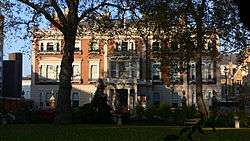Manchester Square


Manchester Square is an 18th-century garden square in the Marylebone area in London, England, a short distance north of Oxford Street. It is one of the smaller but better preserved Georgian squares in central London. The central section of the northern side of the square is occupied by a mansion once known as Manchester House and later as Hertford House, which is now the home of the Wallace Collection, a major collection of fine and decorative arts. The house and square form part of Marylebone's Portman Estate. Construction on both was underway by around 1776.
Famous residents in the square have included Julius Benedict, the German-born composer, who lived at no. 2, John Hughlings Jackson, the English neurologist, who lived at no. 3, and Alfred, Lord Milner, the British statesman and colonial administrator, at no. 14. Admiral Sir Thomas Foley and his wife (later widow) Lady Lucy Anne FitzGerald occupied no. 1 as their London townhouse during the first half of the nineteenth century. In 1814 and 1815 Manchester Square became briefly famous, when newspapers reported that a pig-faced woman was living there.[1]
The cover photograph for Please Please Me, the first LP by The Beatles, was taken by Angus McBean in 1963. It showed the group looking down over the stairwell inside EMI House in Manchester Square, EMI's London headquarters at the time (now demolished). A repeat photo was taken in 1969 for the cover of their then-intended Get Back album; it was not used when the project saw release as Let It Be, but was eventually used on the retrospective albums 1962–1966 and 1967–1970.
In the early 21st century, the chemical company ICI moved into a new headquarters in the north-west corner of the square, which was designed in a style that blends in with the traditional architecture to some extent. The remainder of the square is still occupied by tall brick Georgian terraced houses, many of which are now offices.
Manchester Square Fire Station, actually a few blocks away in Chiltern Street, was decommissioned in June 2005 by the London Fire and Emergency Planning Authority (LFEPA), and is now a luxury hotel and restaurant.[2]
References
- Georgian London (1945) by Sir John Summerson. ISBN 0-7126-2095-8.
- ↑ Bondeson, Jan (2006). The Pig-Faced Lady of Manchester Square & Other Medical Marvels. Stroud: Tempus Publishing. p. 75. ISBN 0-7524-3662-7.
- ↑ Welham, Jamie (7 November 2008). "It's a rare thing: A luxury hotel plan with community support". West End Extra. Retrieved 17 June 2014.
Coordinates: 51°31′00″N 0°09′10″W / 51.5167°N 0.15272°W